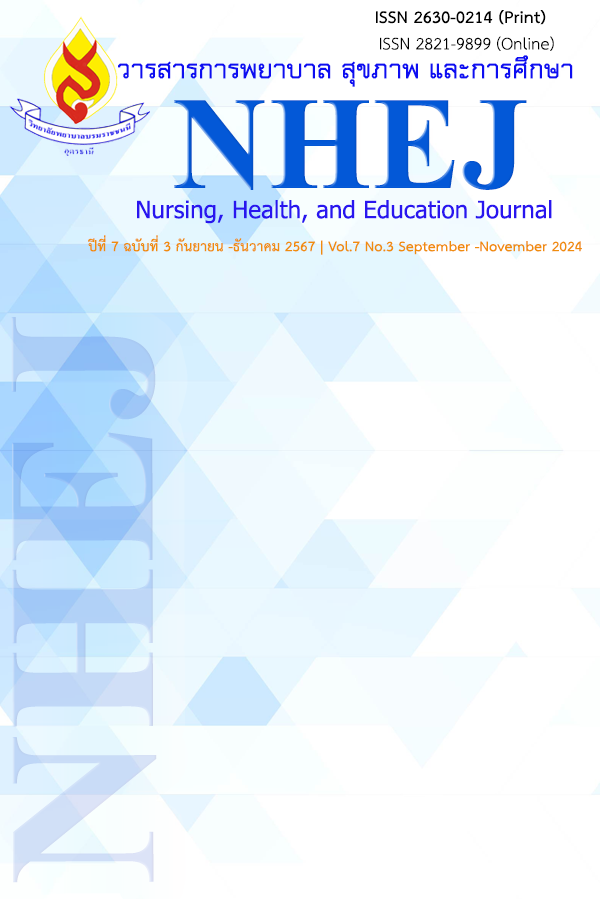Effects of Discharge Planning on Self-Care Behavior and Infection Rates in Percutaneous Nephrostomy Patients, Lamphun Hospital
Abstract
AbstractIntroduction: Infection from a percutaneous nephrostomy is caused by incorrect care behavior. Discharge planning can help patients develop appropriate self-care behaviors after discharge from the hospital.
Objective: To investigate the effects of discharge planning on self-care behavior and infection rates in percutaneous nephrostomy patients.
Research Methodology: This study was quasi-experimental research with a 2-group design with post-test measurements. The sample was randomly selected into a control group and an experimental group of 16 participants each. The research instruments consisted of a lesson plan for providing self-care advice, a self-care guide, a self-care behavior questionnaire, and an infection record form. The data were analyzed by using Fisher's exact test and Mann-Whitney U test statistics.
Findings: The self-care behavior scores of the percutaneous nephrostomy patients in the experimental group were higher than the patients in the control group with statistical significance at .001. Furthermore, the experimental group had an infection rate of 6.25, which was significantly lower than the control group with an infection rate of 56.25%, with statistical significance at .01.Clearly, therefore, discharge planning improved the self-care behavior of the percutaneous nephrostomy patients and can reduce urinary tract infection rates.
Conclusions: Discharge planning promotes better self-care behavior and reduces infection rates in in percutaneous nephrostomy patients this group of patients.
Recommendations: The findings can be implemented in the care of percutaneous nephrostomy patients.
Keywords: discharge planning, self-care behavior, percutaneous nephrostomy patients
References
เอกรินทร์ โชติกวาณิชย์ ธเนศ ไทยดำารงค์ ณัฐพงศ์ บิณษรี บิณษรี เปรมสันต์ สังฆ์คุ้ม และกิตติพงษ์
พินธุโสภณ, บรรณาธิการ. ภาวะฉุกเฉินทางศัลยศาสตร์ยูโรวิทยา (Urological Emergency).
พิมพ์ครั้งที่ 1. นนทบุรี: สมาคมศัลยแพทย์ระบบปัสสาวะแห่งประเทศไทย ในพระบรมราชูปถัมภ์; 2563.
Khan MA, Shamsi A. Obstructive uropathy: an overview. Journal of Clinical Urology. 2019; 12(2):109-118.
ศุจินทรา บัวชื่น. การพยาบาลผู้ป่วยหลังผ่าตัดใส่สายระบายปัสสาวะผ่านผิวหนังเข้ากรวยไต รักษาภาวะ
อุดกั้นระบบทางเดินปัสสาวะ. วารสารพยาบาลศาสตร์และสุขภาพ. 2565; 45(1): 5-17.
สุกัญญา คล้ายชู. ปัจจัยที่มีความสัมพันธ์กับคุณภาพชีวิตของผู้ป่วยที่มีภาวะอุดกั้นทางเดินปัสสาวะที่ได้รับการใส่สายระบายปัสสาวะที่กรวยไตผ่านผิวหนัง [วิทยานิพนธ์พยาบาลศาสตรมหาบัณฑิต]. กรุงเทพมหานคร: คณะพยาบาลศาสตร์ จุฬาลงกรณ์มหาวิทยาลัย; 2560.
เกศรินทร์ อุทริยะประสิทธิ์, ปรางทิพย์ ฉายพุทธ, วัลย์ลดา ฉันท์เรืองวณิชย์, บรรณาธิการ. สาระหลักทางการพยาบาลศัลยศาสตร์ เล่ม 1. พิมพ์ครั้งที่ 5. กรุงเทพฯ: โรงพิมพ์วัฒนาการพิมพ์; 2561.
โรงพยาบาลลำพูน. สถิติผู้ป่วยที่เข้ารับการรักษาในโรงพยาบาลลำพูน. ลำพูน: โรงพยาบาลลำพูน; 2566.
ประดิพัทธ์ จันทาพูน, กฤตพัทธ์ ฝึกฝน, กรรณิกา สมสิทธิ์. ผลของการสอนโดยให้คำแนะนำร่วมกับการใช้คู่มือการดูแลตนเองต่อพฤติกรรมการดูแลตนเองและอัตราการติดเชื้อในผู้ป่วยใส่สายระบายน้ำปัสสาวะออกจากกรวยไต. วารสารเครือข่ายวิทยาลัยพยาบาลและการสาธารณสุขภาคใต้. 2564; 8(3):72-84.
ศุภรดา ประเสริฐกุล. การพัฒนาคุณภาพการวางแผนจำหน่ายสำหรับผู้ป่วยโรคไตวายระยะสุดท้ายที่ได้รับการล้างไตทางช่องท้องอย่างต่อเนื่อง โรงพยาบาลนครพิงค์: [วิทยานิพนธ์พยาบาลศาสตร
มหาบัณฑิต],เชียงใหม่; 2566.
Leinert C, Fotteler M, Kocar T. D, Brefka S, Schindler B, Denkinger M.D. Discharge planning from hospital. 2022; 55(8): 717-719.
รัตนา นิลเลื่อม, ดวงกมล วัตราดุลย์, พรทิพย์ สินประเสริฐ, กรองแก้ว ทรัพย์ประเสริฐ, ธิดารัตน์ ขาวเงินยวง และ อรทัย บุญชูวงศ์. ประสิทธิผลของโปรแกรมการวางแผนจำหน่ายต่อความรู้ และพฤติกรรมการดูแลตนเองของผู้ป่วยโรคเบาหวานชนิดที่ 2 โรงพยาบาลราชบุรีจังหวัดราชบุรี. 2564; 32(2): 202 – 216.
เพ็ญศรี ปัญโญ, อรพิน มโนรส และ มะลิ การปักษ์. ผลของโปรแกรมการวางแผนจำหน่ายร่วมกับการใช้แอพพลิเคชั่นในการให้ความรู้ต่อความรู้ และความสามารถในการดูแลตนเองของผู้ป่วยโรคต้อกระจก ที่เข้ารับการรักษา ในหอผู้ป่วยจักษุ โสต ศอ นาสิก โรงพยาบาลแพร่. วารสารการแพทย์และวิทยาศาสตร์คลินิก โรงพยาบาลแพร่. 2567; 31(2): 1-16.
ธิดาลักษ์ แก้วแจ่ม, ศิริกาญจน์ จินาวิน. ผลของการวางแผนจำหน่ายผู้ป่วยปัสสาวะปนเลือดโดยใช้รูปแบบ D-METHOD ต่อทักษะใน การปฏิบัติตัวและความพึงพอใจในบริการพยาบาล. วารสารการแพทย์และวิทยาศาสตร์คลินิก โรงพยาบาลแพร่. 2567; 32(1): 1-11.
Ganter Ritz V, Speroni KG, Walbridge D. Reducing Complications and Hospitalizations Through an Innovative Catheter Care Clinic for Percutaneous Nephrostomy Catheter Patients. Journal of Radiology Nursing. 2016; 35(4):275-280.
Orem DE, Taylor SG, Renpenning KM. Nursing: Concepts of practice. 6th ed. St. Louis: Mosby; 2001.
Faul F, Erdfelder E, Lang AG, Buchner A. G*Power 3: a flexible statistical power analysis program for the social, behavioral, and biomedical sciences. Behavior Research Methods. 2007; 39(2): 175-191.
Shepperd S, McClaran J, Phillips CO, et al. Discharge planning from hospital to home. Cochrane Database Syst Rev. 2010; 20(1):CD000313.
Helmy NM, Aly AA, Atia RRA, Mohammed BMA, Abouelezz ZGM. Effect of Educational Guidelines on Nurses' Performance regarding Percutaneous Nephrostomy Tube. Egyptian Journal of Health Care. 2023; 14(1):578-593.
Azer SZ, Abd-El Mohsen SA, Sayed SY. The effect of nursing guidelines on minimizing incidence of complications for patients with percutaneous nephrostomy tube. American Journal Nursing Research. 2018; 6(5):327-334.
คนึงนิจ เพชรรัตน์, สัญญา ปงลังกา, จุฑามาศ กิติศรี. ผลของโปรแกรมการพยาบาลแบบระบบสนับสนุนและให้ความรู้ต่อพฤติกรรมการดูแลตนเองและการควบคุมความดันโลหิตในผู้ป่วยโรคความดัน
โลหิตสูง. พยาบาลสาร มหาวิทยาลัยเชียงใหม่. 2561; 45(1): 37-49.
กมนวรรณ นิลเอก และรุ่งนภา จันทรา. ผลการใช้โปรแกรมการวางแผนจำหน่ายต่อความสามารถในการดูแลตนเอง และคุณภาพชีวิตของผู้ป่วยไฟไหม้น้ำร้อนลวก หอผู้ป่วยศัลยกรรมชาย 4 โรงพยาบาล
สุราษฎร์ธานี. วารสารวิชาการแพทย์. 2562; 33(2):143-156.
Downloads
Published
How to Cite
Issue
Section
License
Copyright (c) 2024 Boromarajonani College of Nursing Udonthani

This work is licensed under a Creative Commons Attribution-NonCommercial-NoDerivatives 4.0 International License.



